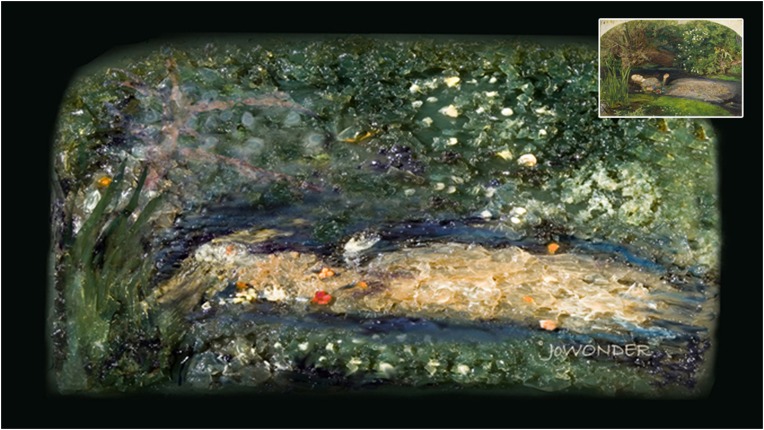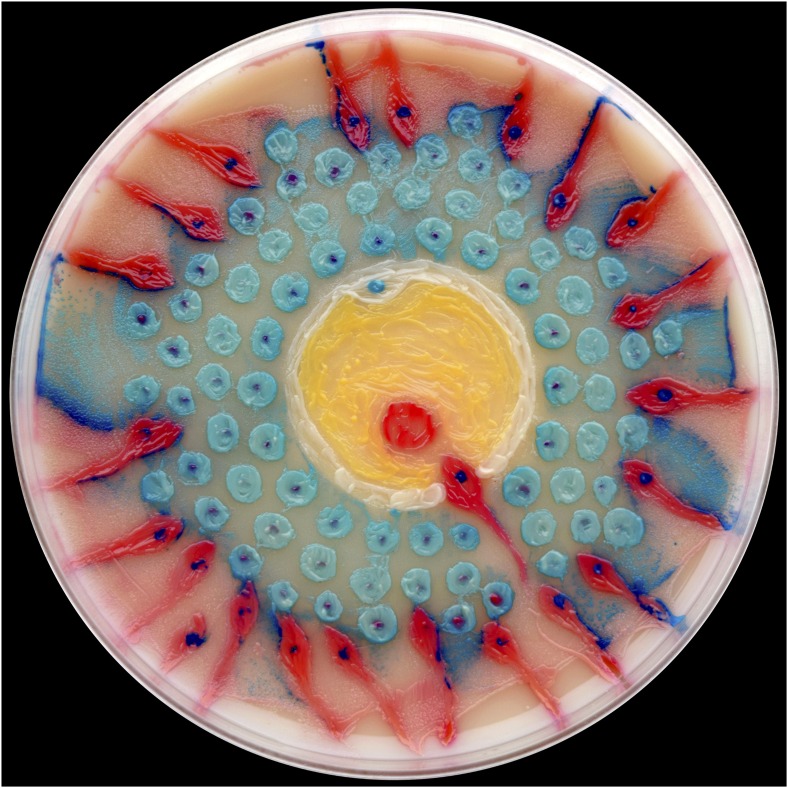Maria Peñil Cobo’s purple-gloved hands move from palette to canvas in a regular rhythm. She dabs a red spot and brushes it in arcs, then adds strokes of yellow that swirl through the red. But when she puts her tools away, her painting is still a blank canvas. Her artwork isn’t just life-like, it’s actually alive. It will take days to grow and reveal its colors.
Microbiologist Simon Park collaborated with artist Jo Wonder to create a microbe-based replica of Sir John Everett Millais’ 1851–1852 masterpiece, Ophelia (Inset). Main image courtesy of JoWonder (artist), Inset copyright Tate, London (2016).
Peñil Cobo, whose “studio” is part of researcher Mehmet Berkmen’s laboratory at New England Biolabs (she volunteers her time as part of an informal arrangement), is one of a niche group of scientists and artists who use microbes as a medium to create artwork. Vivid microbes have long inspired researchers to attempt painting; Alexander Fleming famously created a series of “Germ Paintings” using molds and bacteria, including some where Penicillium strains secreted penicillin and blurred parts of his artistic creations.
Today’s microbe artists and artist–researcher collaborations often create microbial art, in part, as a means of public outreach, an effort to help the general public overcome their instinctive germ-inspired disgust. From museum exhibits to undergraduate classrooms, art made on agar is made with a purpose common to both art and science: to inspire curiosity and wonder. “A lot of our art is driven by this misconception that people have that bacteria are very simple things that are harmful,” says microbiologist Simon Park of the University of Surrey. That perspective he says, is “a long way from our modern scientific understanding.”
Living Paint
When artist Jo Wonder approached Park to embark on a collaboration to create a microbe-based replica of Sir John Everett Millais’ 1851–1852 masterpiece Ophelia in 2006, Park began by collecting bacteria from around the world. For a few weeks, Park sought out new hues in standard culture collections and reached out to researchers to acquire strains. Wonder then worked in his laboratory to create the microbial version of Ophelia.
The palette Park and Wonder curated, known as C-MOULD, now includes more than 50 species of bacteria and fungi, and is the most extensive collection of microbes for art. The collection serves as an “out of the box” palette that they and other scientists draw from to produce art. Many species produce varied hues; others create textures or add special effects. One species, known as Cupriavidus metallidurans strain CH34, precipitates gold chloride into elemental gold via an enzymatic reaction, adding a glitter effect. Peñil Cobo and Berkmen use a similar collection of pigmented and textured microbes for their work. Others rely on microbial bioluminescence rather than pigments for color, producing art that’s lit by a glowing blue-green hue. To create patterns, some microbial artists use paintbrushes or platinum-inoculating loops a few millimeters wide (the tool researchers typically use to streak out bacterial cultures). Others prefer to allow bacteria themselves to grow into abstract, fractal patterns.
The microbes are my collaborators in the art. You can't really say that about most media.
—Simon Park
Paintings also need to be carefully timed and treated so all of the pigments mature at the same time. The process can take days or weeks, Berkmen explains. For example, a bright red Arthrobacter strain they use was originally isolated as a contaminant from their refrigerator, where it thrives in the cold. Peñil Cobo will often begin with other strains that need warm incubators to grow and, at the end, add Arthrobacter before placing a painting in the refrigerator to grow into its final form. Understanding how to time different strokes can take several attempts, says Berkmen.
The burgeoning range of techniques and artistic styles is evident in entries to competitions, such as the American Society of Microbiology’s (ASM) Agar Art contest, now in its second year. The contest—first proposed after the ASM staff noticed how popular microbial art pictures were on social media—received more than 100 entries this year from around the world. Whereas many were recreations of famous paintings, such as Monet’s Water Lilies or Edvard Munch’s The Scream, others portrayed nature-themed images or even interpretations of classic art.
“We were really surprised by the amount and variety of art,” says Chaseedaw Giles, marketing coordinator at the ASM who manages the contest. “We see more than just color or streaking techniques; one entry this year made a picture of beer that’s actually bubbling where they treated bacteria with hydrogen peroxide to make a foam. We’d never seen anything like it before.”
The entry, inspired by René Magritte’s famous painting of a pipe, was titled This is Not a Beer, and won second place in the 2016 contest. The winning entry, which used four species of bacteria and a selective growth medium, depicted the process where sperm cells meet an egg (For more on the winners, see www.microbeworld.org/backend-submitted-news/2132-announcing-asm-s-agar-art-2016-winners).
The 2016 winner of the American Society of Microbiology’s Agar Contest, titled The First Race, depicted fertilization. Graduate student Md Zohorul Islam of the University of Copenhagen “painted” with four bacteria on a selective agar canvas. The red was Staphylococcus aureus, a pathogen in both humans and animals. Staphylococcus xylosus, a commensal organism in human skin, generated green. The white was Staphylococcus hyicus, an animal pathogen responsible for grassy pig disease. And yellow came from Corynebacterium glutamicum, a bacterium used to produce amino acids, such as l-glutamate and l-lysine. Other colors came from mixing two or more of these microbes. Artwork by Md Zohorul Islam (University of Copenhagen, Copenhagen). Image courtesy of American Society for Microbiology.
Critter Collaborators
All bacterial art presents its creators with a curious problem: The creation on their canvas is constantly changing. Because microbial paint is alive, artwork matures within a day or two and then begins to decompose. To many artists, bacterial death is part of their creation. Geneticist and bio-artist Hunter Cole, of Loyola University in Chicago, takes time-lapse photographs of her microbial art, which uses bioluminescent bacteria, as each piece grows, ages, and dies. For one piece, Cole displayed the time-lapse photos as a movie set to music based on the protein sequence of the lux gene, which makes the protein responsible for bioluminescence.
In one of her Living Drawings series, Cole painted a rabbit and rooster together on a Petri plate. As the bacteria died in different patterns, the rooster appeared to turn into a wolf. “It’s almost like a Grimm fairy tale,” says Cole. “Even if I created the exact same drawing again it might not die off in the same way.”
To Cole and other microbe artists, the unpredictability of their paints is part of the process. Park relies, for example, on swarming to create patterns. The bright red bacterium Serratia marescens is highly motile and swarms quickly through any painting.
Such phenomena “take the work away from being truly produced only by an artist, and represent invisible events taking place in the microscopic world,” Park says. “The microbes are my collaborators in the art. You can’t really say that about most media.”
Colorful Learning
Some of these artists and their colorful collaborators have started to go on display in museums. In one recent exhibit in Baltimore, titled Culture as Medium, curator Margaret MacDonald, who's in the Master’s program at the Maryland Institute College of Art and already holds a doctorate in chemistry, combined the aesthetics of an art show with the interactivity of a public outreach event. Artists at the exhibit showcased pieces, such as the 1000 Handshakes project, where François-Joseph Lapointe, Professor of Biology at the University of Montreal, shook hands with people in public markets or tourist spots and then cultured the changing microbiome of his palms.
To MacDonald, exhibits such as this are a means for artists, scientists, and their audiences to place advances in microbiome research in the context of their own lives. “We’re at a moment where, because research on the microbiome is expanding, it’s a bit of the Wild West,” she says. “It’s really critical at this point to bring in some of these artistic considerations and ask questions about the big picture: What does it mean to be human now? How does this science fit into how we understand ourselves? Art is an opportunity to meditate on those concepts.”
As an artist and waitress, Peñil Cobo recalls her own revelation. She admits that she too was once repulsed by germs. But working long hours in the laboratory to produce art from microbes has changed her views on both science and art. Now she’s not shy about seeking out microbes for her art everywhere. For one recent piece, she began by kissing a Petri plate, then used isolates from her own lips to create a new painting. And she’s gained an appreciation for a more scientific approach. “Initially, Maria was very free-thinking and adventurous,” says Berkmen, who helped her learn how to work with microbes safely. “Now, when I come up with a suggestion for a new piece, she’ll first say we need to test it, and try some controls … she’s thinking more like a scientist.”




